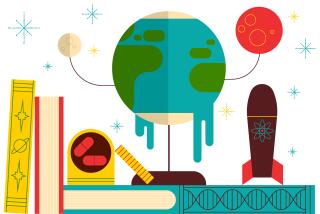Welcome to Web 2.0
IN the heady days of the late ‘90s Internet boom, the business aisles at bookstores overflowed with tales of accidental software billionaires and breathless pronouncements that the Web was the greatest advance since the taming of fire. If you find yourself nostalgic for that era of irrational enthusiasm, take heart, because the old hype is being reshaped and reshipped as Web 2.0.
David Weinberger is perfectly placed to tell us what’s really new about this second-generation Web. A fellow at Harvard Law School’s Berkman Center for the Internet & Society, coauthor of “The Cluetrain Manifesto: The End of Business as Usual” (a classic of Web 1.0 hype), and author of “Small Pieces Loosely Joined: A Unified Theory of the Web” (a book more thoughtful and less bombastic than its subtitle suggests), he’s experienced in marketing, entrepreneurship and even politics -- he was the senior Internet advisor to Howard Dean’s presidential campaign. Drawing from all these perspectives, Weinberger describes how the Web is evolving into a truly social system. Whereas Web 1.0 users’ characteristic activity was surfing static Internet pages, Web 2.0 is more participatory: Users upload content and actively shape their environment. Blogs are the best-known evidence of this shift, but Weinberger is particularly interested in the explosion of such sites as Flickr (for sharing photos), YouTube (for posting videos) and del.icio.us, a social bookmarking site where users categorize, collect and share their Web discoveries.
Weinberger sees this user-directed labeling, or “tagging,” as key to the latest transformations of the knowledge economy. Tags are metadata (defined as information about information). To illustrate the importance of tagging, Weinberger compares the way people used to organize photo albums with the new modes engendered by the explosion of digital snapshots. Printed photos were expensive; we would select just a few and put them in order, often by year, sometimes with labels like “Family Vacations.” But in the digital age, we generate many more images (it’s easier to keep them than cull them), and the labels the camera automatically assigns them are obscure (DSC00165.jpg and the like). This is classic disorder: thousands of files with inscrutable names on multiple devices. But as Weinberger sees it, “the solution to the overabundance of information is more information.” Thus we can slot them into one virtual album or many, tag them with personal references for our own use or post them to the Web with generic identifiers so anyone interested in searching for them can find them.
“Everything Is Miscellaneous” embraces this disorder, insisting that “we have to get rid of the idea that there’s a best way of organizing the world.” This shift is a result of more powerful search features in networked environments: What matters is not how accurately you label and position something in digital space but how widely you allow others to cast their nets and capture your contribution. What you want to provide -- and to have others provide -- is “faceted classification,” which takes advantage of the fact that “computers have become demonically good at sorting through gigantic, complex piles of information.”
Weinberger tries to get a handle on the changes that broadband networks, ubiquitous access, fast processors, huge hard drives and vast databases have brought about in culture and commerce. The neologisms fly fast and furious: folksonomies (taxonomies created by ordinary people rather than professional archivists), spimes (objects that seem aware of their position in space and time), wikis (sites that users can enter and modify easily, from the Hawaiian for “quick”) and intertwingle (perhaps you can figure that one out by yourself).
The author’s attraction to miscellany is obvious, but clarity is called for in a project like this. Rather than synthesizing, Weinberger adopts the formula that Malcolm Gladwell established in his bestsellers “The Tipping Point” and “Blink” -- cycling from personal anecdote to potted history to business case studies. So we get a discussion of the difference between Weinberger’s wife’s meticulous organization of their silverware drawer and the way Weinberger’s old college buddies rooted around in a pile of knives and forks, followed by overlong disquisitions on Linnaean biological taxonomy and the Dewey Decimal System, followed by arguments that the BBC is “radical” and Staples, the office-supply chain, is “revolutionary.” (Remember those overused words from the last boom?) It’s not that there aren’t good things to be learned from “Everything Is Miscellaneous,” it’s just that they seem somewhat -- well, miscellaneous. So amusing trivia -- a German pastor once condemned the immorality of Linnaeus’ sexual taxonomy of plants -- obscures insightful analyses, like the one Weinberger offers on how Wikipedia, the amateur user-generated encyclopedia, regulates itself so well.
Because of the connectionist composition of the arguments -- first this, then that and then yet another thing -- “Everything Is Miscellaneous” occasionally reads like a primer on postmodernism for corporate marketers. Weinberger ignores one of the prime reasons we try to impose order on our chaotic environments: There is only so much time allotted in this life, and we are, therefore, forced to engage in what I’ve come to call info-triage, ruthlessly selecting rather than simply adding. So, when Weinberger lists a dozen-plus items of metadata about “Moby-Dick,” what he doesn’t quite get to is how we’ll actually manage to read this 208,968-word masterpiece, given its “Fog Index (a standard measure of readability) ... of medium difficulty,” if we’re spending so much time loping through statistical indexes.
“The task of knowing is no longer to see the simple,” Weinberger writes. “It is to swim in the complex.” “Everything Is Miscellaneous” gets us down to the shore but teaches us few new strokes.
More to Read
Sign up for our Book Club newsletter
Get the latest news, events and more from the Los Angeles Times Book Club, and help us get L.A. reading and talking.
You may occasionally receive promotional content from the Los Angeles Times.






